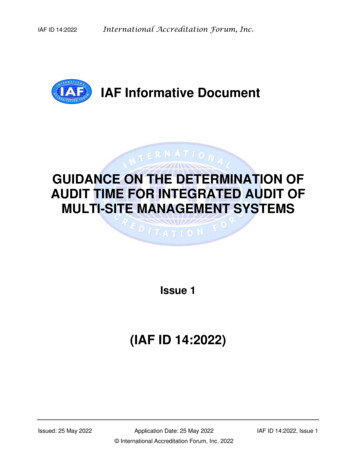
Transcription
Cyber SecurityNEWSVol. 3 Issue 5May 2018NK Old Worm USB Healthcare Phishing Echo Fish Reader Stats ChallengeHello everyone and welcome to this month’s TXDPS Cyber Newsletter.Hopefully everyone survived tax season relatively unscathed without owing anything or falling victim to any scams. Thismonth I found a few articles which I believe you will find interesting and hopefully useful. For the month’s “theme” I decided to focus on the dangers of Social Engineering and the Internet of Things (IoT). The dangers of Social Engineering tothe Agency cannot be stressed enough. It is a danger anyone can fall victim to and must be ever vigilant to defend against.The other theme, Internet of Things, could be a danger not only to the Agency but it is an even greater danger to you personally. Hopefully this month’s articles will educate you on some topics you were not aware of as well as pique your interest to learn more.I have added a new section to the newsletter; Reader Suggestions. The section, as the name implies, will be dedicated toarticles of interest employees send me. My hope is that for all future newsletters I will have multiple articles or topics topost. If you have a suggestion or come across an interesting article, please let me know.1
Cyber News!!North Korea-linked hackers stole data from 17 countries in an ongoing cyberattack that’s farbigger than we thoughtA North Korea-linked hacking group has been tied to a series of cyberattacks spanning 17 countries, far larger than initiallythought.A new report by McAfee Advanced Threat Research found a majorhacking campaign, dubbed Operation GhostSecret, sought to stealsensitive data from a wide range of industries including hcare,andtelecommunications.Attackers used tools and malware programs associated with the NorthKorea-sponsored cyber unit Hidden Cobra, also known as Lazarus, toexecute the highly sophisticated operation.Click HERE to read more.Old Worm, New Tricks: FacexWorm Targets Crypto PlatformsMalicious Chrome extension FacexWorm has reappeared with new capabilities, targeting cryptocurrency platforms and liftinguser data.FacexWorm, a malicious Chrome extension, has been rediscovered targeting cryptocurrency trading platforms and spreadingvia Facebook Messenger. The Cyber Safety Solutions team at Trend Micro reports it’s packing a few new capabilities,including the ability to steal user data.The extension was first detected in August 2017 and returned the following April amid reports of increased appearances inGermany, Tunisia, Japan, Taiwan, South Korea, and Spain. Like the original, it sends socially-engineered links to friends ofaffected Facebook account holders.Click HERE to read more.A malicious USB stick could crash your Windows PC, even if it’s lockedPlugging a USB drive containing a malformed NTFS image into a Windows machine can cause it to bluescreen in mereseconds, according to Marius Tivadar of BitDefender.Tivadar recently published his NTFS image on GitHub after dissatisfaction with Microsoft’s response. He initially reportedthe bug in July 2017, and “they did not want to assign CVE for it nor even to write me when they fixed it,” Tivadar said.Microsoft replied to Tivadar, saying “Your report requires either physical access or social engineering, and as such, does notmeet the bar for servicing down-level (issuing a security patch).”Attempts to test the code have had varying results, with one commenter on Bleeping Computer saying the bug doesn’t work asTivadar claims. Whether or not Tivadar’s code is as effective as he said it is doesn’t matter, as another Bleeping Computercommenter said.Click HERE to read more.2
More Cyber News!!Why Hackers Love HealthcareThe migration of valuable data to the cloud is piquing the interest ofcybercriminals. But there are ways to fight back.Much like the rest of the world, healthcare organizations are shifting work tocloud services in order to improve accessibility and patient care. However, themigration of these workloads and moving valuable information such as PHI(personal health information) and PII (personally identifiable information) to thecloud has also led to cybercriminals taking a particular interest in the industry.The number of ransomware and other malware attacks is rising incredibly fast inthe healthcare industry, putting human lives as well as critical data at risk. From2011 through 2014, the sector—including hospitals, labs, pharmacies, drugcompanies and outpatient clinics—experienced the highest number of databreaches of all industries. What makes these organizations such a populartarget?Click HERE to read more.Vade Secure Discovers New Phishing Attack Targeting 550 Million Email Users GloballyVade Secure has discovered a new phishing attack thatrepresents more than 550 million emails sent since Q12018. First detected in early January, the phishing attackis targeting consumers around the world. Countries withhigh concentrations of impacted email users include theUS, UK, France, Germany, and the Netherlands.The phishing attack attempts to steal users’ bank accountdetails by offering them a coupon or discount inexchange for participating in a quiz or online contest.The emails masquerade as popular brands, onlinestreaming services, and telecom operators based on thecountry of the recipients. Examples include CanadaPharmacy in the US, as well as Orange and Carrefour inFrance. Moreover, the content of the messages isadapted according to the local language.Click HERE to read more.3
More Cyber News!!Getting an Amazon Echo app to silently eavesdrop on youIn news that will surely be a surprise to nobody, apps that run onAmazon’s home assistant, Echo, can be turned into silenteavesdroppers: no fancy hacking required, no new Echovulnerability pried open.Or at least they could, until Amazon fixed it.Researchers at information security firm Checkmarxdemonstrated what we probably all suspected was possible buthoped wasn’t by tweaking options in Alexa’s softwaredevelopment kit (SDK) – the kit that’s used to develop software,known as skills, for the Echo.The voice-activated skills are the equivalent of the apps on yourphone: discreet bits of software that add capabilities to the device. There are skills for finding open restaurants near you,getting Starbucks started on your coffee order, checking your bank balance, hearing the latest news and turning on theChristmas lights.And on somebody’s desk at Checkmarx, there’s one for eavesdropping on you. It silently captures transcripts of what you’resaying and sends them to an external log accessible to the researchers who rigged the trap.Click HERE to read more.Hackers once stole a casino’s high-roller database through a thermometer in the lobby fishtankLONDON - Hackers are increasingly targeting“internet of things” devices to access corporatesystems, using things like CCTV cameras or airconditioning units, according to the CEO of acybersecurity firm.The internet of things refers to devices hooked up tothe internet, and it has expanded to include everythingfrom household appliances to widgets in power plants.Nicole Eagan, the CEO of Darktrace, told the WDJCEO Council Conference in London on Thursday:“There’s a lot of internet-of-things devices, everythingfrom thermostats, refrigeration systems, HVAC systems, to people who bring in the Alexa devices into the offices. There’sjust a lot of IoT. It expands the attack surface, and most of this isn’t covered by traditional defenses.Click HERE to read more.4
Reader SuggestionsAs you can see, I have added a new section to the newsletter. This section will be dedicated to articles of interest thatemployees send me. This month’s submission is from the DPS CJIS Department. The article is from News Channel 10 inLubbock and is about a homeless man who used Social Engineering skills to convince a dispatcher in Lubbock to run licenseplates for him. The article is short so I will just post the whole thing.LUBBOCK, TX (KCBD) - According to the police report, 58-year-old Eliseo Benites, a homeless man from Lubbock, hasbeen indicted by a Lubbock County Grand Jury on charges of impersonating a public servant.According to the police report, Benites pretended to be a police officer in order to get license plateinformation. The police report also says Benites was successful in getting information for at leastone license plate.Benites called the police department on at least three occasions and possibly more, according to thereport.The indictment says Benites called the Lubbock Police Department dispatch for the information.He is being held in the Lubbock County Detention Center on bonds totaling more than 20,000.Copyright 2018 KCBD. All rights reservedArticle is no longer available.Social Engineering is a non-technical cyber danger. In very basic terms it is the psychological hacking of a human and isoften the first step hackers take in the reconnaissance phase before an attack. The techniques used in Social Engineering arevery similar to techniques investigators, interrogators, and sales/marketing people use to do their jobs. I could spend lots oftime explaining how this is done but seeing is often the best teacher. Please watch the following links when you get a chanceto see just how this is done.Professional Social Engineer & ScammerSocial Engineering FraudSocial Engineering for Fun and ProfitDavid KennedySimple Social EngineeringSocial Engineering: The Gentleman ThiefYou can also go to this Agency internal link to see a PowerPoint presentation about the topic. Go down to slide 54 to learnmore about Social Engineering.Please send me any articles you think would be of interest to be added into the monthly newsletter. Email me atkirk.burns@dps.texas.gov.5
Cyber Stats for Mar and Apr Phishing attacks against agencyEmails blocked by sensorsDPS Custom Email Threat Signatures CreatedCyber SecurityMarch 2018% ChangeApril 20181717.65%20Pending Code100.00%125,7002850.00%19122% increase in the number of IOCs being trackedAs you can see from this month’s stats, phishing attacks against the agency have slightly risen from last month. The chartalso shows a significant increase in Custom Email Threat Signatures and Incidents of Compromise (IOC). Even though thenumbers are higher, it doesn’t mean we are being targeted any more than normal. Attacks will fluctuate and the numbersonly indicate just how good a job our Cyber Ops and IT teams are doing to protect the agency.For this month’s stats I would also like to includesome information one of our new team members(Dylan) found in an independent study commissioned by IBM and published last year (2017). Theyfound the following results (see graphs).There are a few things I would like you to take awayfrom these graphs. First is that 52% of all databreaches are from malicious attacks, but almost 1/4(24%) were from human error. The second is thecost of these data breaches. While malicious attackswere more costly, human error isn’t far behind andcan be seen in the graph below. As you can see, thedollar differences per document between the root causes of a breach are negligible. Unsurprisingly, it was also found thelonger a breach went undetected the more costly it was. Breaches found under 100 days had a average cost associated withthem of 5.99 million while those longerthan 100 days rose to 8.7 million.Data Breaches also take a significantamount of time, and resources to recoverfrom. Not to mention the amount of lostrevenue and eroding of customer confidence in the organization. In their study,IBM found 45% of the cost of databreaches is from lost customer businesswith the next most costly being Legal at19% and Investigations and Forensicsbeing 18%.6
CyberChallengeCyber ChallengeThis month’s Cyber Challenge is more of an awareness challenge. I am going to challenge you to take a look at the worldaround you and see how many devices are now connected to the internet. I think it will surprise you just how manycommon things are now being attached to the Internet. For example, the fish tank thermometer mentioned in one of thismonth’s articles.Recently I came across an IoT device that shocked me. Your eyes are not deceiving you. You really are seeing a BBQGrill that can be attached to your network. I saw it at the Bucky’s in Bastrop last month. While I have not researched it,I’m willing to bet the manufacturer has no plan for updates to the grill if vulnerabilities are found. To help you on yourpath with the awareness challenge, here are some common things that are online you may or may not know about.Tablets, smart phones, smart TVs, refrigerators, home thermostats, home assistance (Echo, Alexa, etc), doorbellcams, home air quality sensors, WeMo, security systems, security cameras, baby monitors, garage door openers,crockpots, ovens, dishwashers, washers and dryers, water heaters, home automation, coffee pots, NEST, lights,light bulbs, smoke detectors, the batteries in smoke detectors, etc.I challenge everyone to think about what malicious things could be done to and with the devices you find. Is it reallynecessary to have a smoke detector’s battery be able to notify you via an app that it needs to be changed? And does themanufacturer routinely update their product to help keep your network safe? If not, are you willing to accept the RISK ofhaving these devices on your (or any) network?KirkNewsletter SupportConnect & ShareGRP Cyber Risk@dps.texas.govSharePoint Twitter7
A new report by McAfee Advanced Threat Research found a major hacking campaign, dubbed Operation GhostSecret, sought to steal . The phishing attack attempts to steal users' bank account details by offering them a coupon or discount in exchange for participating in a quiz or online contest. The emails masquerade as popular brands, online










